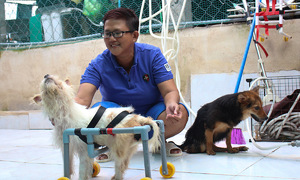Saigonese rehabilitates paralyzed dogs, cats
Saigonese rehabilitates paralyzed dogs, cats
Saigonese rehabilitates paralyzed dogs, cats
Saigonese rehabilitates paralyzed dogs, cats
Early morning, several dogs have started barking in a 300-meter-square house located in the middle of a farm in Hung Long Commune, Saigon’s Binh Chanh District.
Knowing the dogs are hungry, Nguyen Thi Ngoc, homeowner, divides cooked rice into portions for the animals, most of which are paralyzed.
Some canines try to creep to the rice on their two legs, others, completely motionless, lie on the ground and groan.
 |
|
Ngoc takes care of around 100 paralyzed cats and dogs. Photo by VnExpress/Diep Phan. |
After the animals finish their meals, Ngoc starts her “physical therapy session” with Dua Kho, a dog with four paralyzed legs and abandoned in Mekong Delta’s Tien Giang Province. The 46-year-old woman pours some medicinal liquor onto Dua Kho’s legs, which she massages to stimulate muscles and nerves, before placing the little canine into a handmade wheelchair.
“I have treated him for a week. He can walk as long as he has the wheelchair,” Ngoc said. Previously, Hang, a 51-year-old woman from the U.S., had hired a friend to save Dua Kho and send him to Ngoc.
“No one wanted to adopt him during the first three days following his rescue. Luckily, thanks to Ngoc, he can now walk,” Hang said.
Ngoc, a cat and dog lover, has spent the last six years saving and treating disabled canines and felines. The calling came to her accidentally, when she heard a meow on the street and found it was emitted by a paralyzed cat. She took the cat home, naming her Plus.
Living in Saigon’s District 2 with the paralyzed Plus, Ngoc started to study physical therapy, hoping to give her feline friend a new life. With the help of the Internet, she made a wheelchair from water pipes and a belt. This was the first time Ngoc had used a saw, screws and nails, resulting in the odd scratch.
Placing Plus into the new wheelchair, she saw the cat try to move her two front legs as if walking.
“She did not recover completely, but could eat and gain some weight, and lived with me for a year. Since, I have thought if disabled cats and dogs were looked after and had a chance to move around, they could be rehabilitated,” Ngoc said. “Please don’t abandon them.”
 |
|
Ngoc makes an animal wheelchair from pipes. Photo by VnExpress/Diep Phan. |
Now, whenever Ngoc encounters disabled cats or dogs, she brings them home and makes them wheelchairs. Upon their recovery, she finds them new owners. Those severely paralyzed stay with Ngoc.
“I make sure to find them the right families. I usually ask the new owners’ address and visit their homes prior to taking my ‘babies’ over,” Ngoc maintained.
At the start, Ngoc struggled to care for all her new animals, resulting in several dogs and cats dying. Later, she decided to only take in abandoned animals she herself had rescued, or those delivered by acquaintances.
“When people are dirty, they can take a bath, dogs and cats cannot. I decided to take care of them so I need to step up,” she said.
Apart from feeding, Ngoc also spends her money and efforts on treatment. Some recover and can walk after a period of time, but some remain paralyzed for the rest of their lives.
To save up more money, Ngoc starts working as a motorbike taxi driver. She wakes up at 5 a.m. but only hits the streets at noon, after taking care of her animals.
“Only a few people in Saigon could do this because it is hard work,” said Kim Anh, 30, residing in District 4.
The “child” Ngoc remembers most is Roi. Three years ago, she accidentally received a call for help from a friend in Hanoi regarding a dog electrocuted and thrown away on the last day of the lunar new year. With no animal clinics open, the girl had taken home the dog, which was named Roi later. His legs turned necrotic after four days and had to be removed. No one wanted to take care of a legless dog with bleeding wounds.
“If the dog can be transported to Saigon, I will care for him,” Ngoc told her friend. Thanks to Ngoc’s subsequent efforts, Roi healed after a month, but still struggled to move without legs.
 |
|
The happy “mother” and children. Photo by VnExpress/Diep Phan. |
Lunchtime, Ngoc has just finished a delivery order and opens her phone to check on her animals through the camera at home. Seeing Vang, having two hind legs paralyzed, want to bite another dog, she speaks into the phone: “Hey Vang, do not bully your friend.”
The canines at home, hearing Ngoc voice’s on the speaker, look around and stop fighting.
In the saggy house, two fans run around the clock to keep the animals cool under the baking sun. They lie and sleep when the sunlight slants through the metal roof and their “mother” is out to work.
“Now, this means happiness to me,” Ngoc said with a smile before going to pick up another customer.

